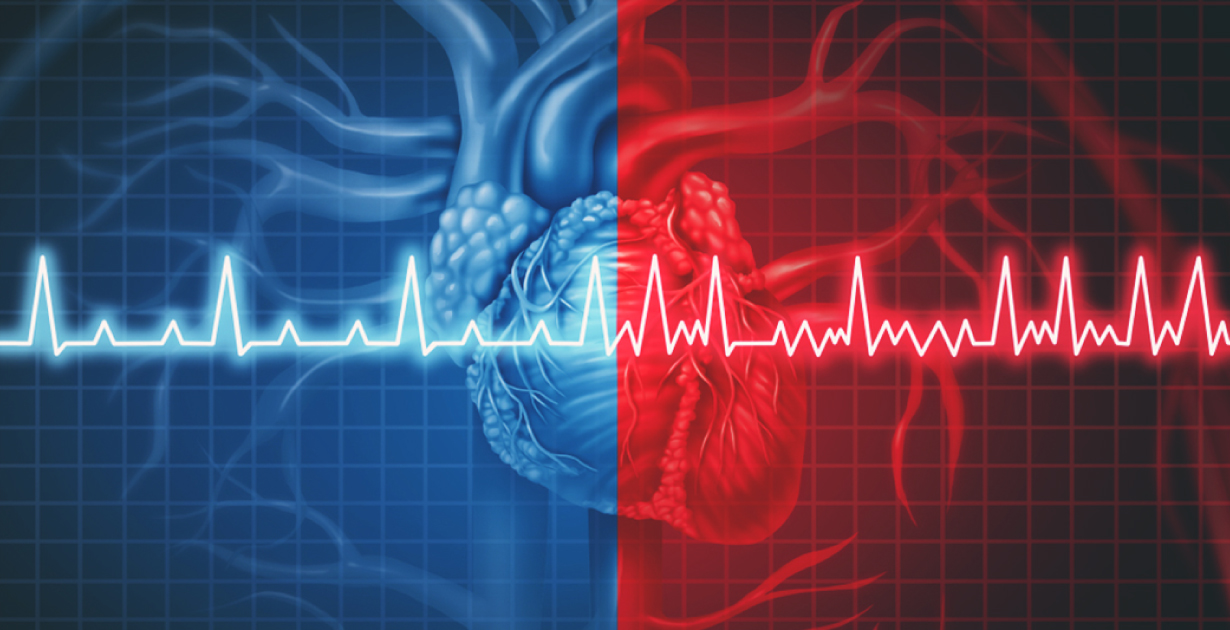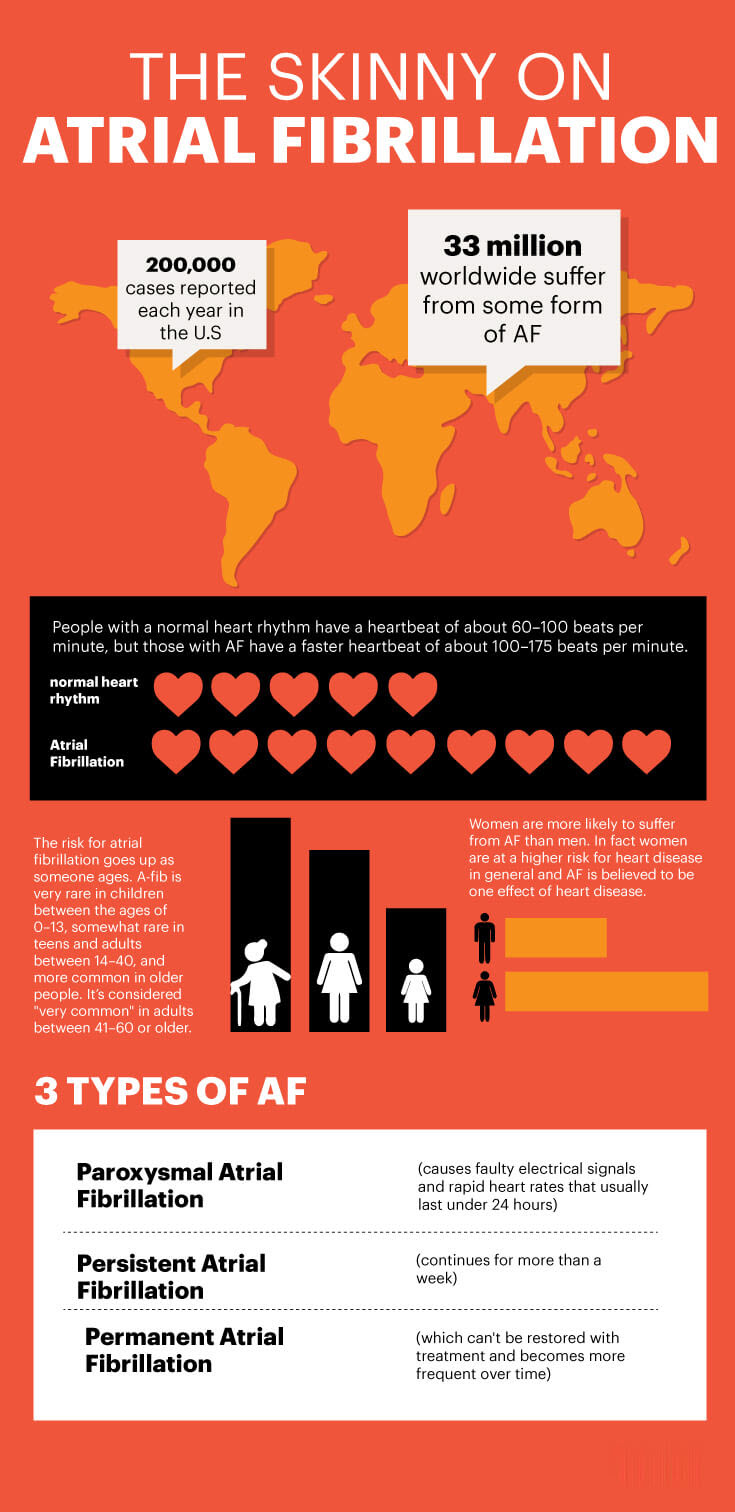 Atrial Fibrillation
Atrial Fibrillation
Also called AF or “A-fib” for short) is a heart condition that causes the heart to beat in an irregular, a sometimes rapid rhythm that can result in poor circulation and other cardiovascular problems.
While some people are unaware that they have AF and feel no symptoms at all, others experience symptoms that at times can feel pretty scary.
including a pounding heart, fluttering in the chest, or even the feeling that their heart “is going to explode.”
A new study showed that atrial fibrillation appears to be more common in women than in men, affects adults between the ages of 45–60 most often, and is a strong risk factor for coronary heart disease.
How common are atrial fibrillations? More than 200,000 cases are reported each year in the U.S. alone, and about 33 million worldwide suffer from some form of AF.
Atrial fibrillations are often considered chronic health problems since symptoms can last for many years or even in someone’s entire lifetime.
That being said, this condition is usually treatable with a good outcome.
A proper diagnosis of AF requires a medical visit and lab or imaging testing, at which point symptoms usually can be managed well with a combination of medications and lifestyle changes
including lowering and relieving stress, reducing inflammation, and improving someone’s diet.
Natural Atrial Fibrillation Treatment Plan
Article fibrillations are tested and diagnosed by primary care providers, cardiologists who specialize in heart disorders, or geriatricians who treat the elderly.
Treatment goals for AF involve resetting normal heartbeat rhythms and preventing blood clots from forming or worsening. Some of the standard medical treatments used to treat patients with AF include:
- taking prescriptions to thin blood, regulate blood pressure, and reduce inflammation
- electrical shock therapy (called cardioversion), which governs the electrical currents of the heart
- when medications don’t work, in some cases surgeries (called ablation) is performed to insert a cardiac monitor or catheter into the heart
- specific lifestyle changes to control complications and prevent inflammation from worsening
While they can be severe and potentially life-threatening for some people, most people who have atrial fibrillations go on to live healthy lives.
Treatments usually help bring the heartbeat back to normal, which helps control symptoms and lowers the risk for complications.
Most people can usually still exercise, often work and lead active lives, assuming they get clearance from their doctors to do so.
Various lifestyle practices can help control arrhythmia symptoms and keep them from getting worse, especially inflammation.
Inflammation is one of the significant risk factors for conditions like heart attack, stroke, diabetes, thyroid disorders, and even mood-related diseases.
6 Natural Ways to Help Control AF Symptoms
1. Get Your Yearly Checkups
It’s essential to stay on top of doctor visits as you get older, especially if you have a family history of heart disease or other known risk factors.
It’s believed that under-diagnosed or under-treated heart disease can contribute to arrhythmia and its complications.
Research shows that women are even more susceptible to risk factors that contribute to heart disease and AF — plus, they have a higher mortality risk associated with it.
Another reason to visit your doctor each year is that research shows that procedures used to correct AF work best if they’re implemented soon after diagnosis.
Atrial fibrillation usually is first treated with lifestyle changes and medications, but also might require procedures such as ablation,
which is a minimally invasive procedure that uses heat or cold administered through a catheter to disconnect the veins that trigger af electrically.
According to researchers from the Cleveland Clinic Section of Cardiac Electrophysiology and Pacing,
“If the diagnosis has been there for less than one year, then the success rate of ablation is up to 80 percent …
it drops down to 50 percent by the time you get to more than six years.”
If an ablation or other procedure is needed, it’s best to perform one sooner rather than later to improve the outcome and avoid the buildup of scar tissue within the heart.
2. Eat an Anti-Inflammatory Diet
One of the leading contributors to heart problems and heart disease is inflammation, which leads to free radical damage.
Obesity also seems to raise the risk of heart problems and AF, which makes it even more important to eat a low-processed, balanced diet. Foods to avoid that promote inflammation most include:
- refined vegetable oils (like corn, safflower, and soybean oils)
- refined carbohydrates and processed snacks that contain them
- conventional, factory-farm meat
- added sugars
- trans fats
- pasteurized, traditional dairy products
- high-sodium foods (many packaged foods and fast foods)
- In the case of partial fibrillations, high amounts of caffeine and alcohol can also make the problem worse.
- Venerability varies from person to person depending on how severe the AF is, but research shows that binge drinking (having five drinks in two hours for men or four drinks for women) puts you at higher risk for AF as does drinking caffeine, particularly if you have a caffeine overdose in your diet
These foods can also increase gastrointestinal disorders, thyroid disorders, autoimmune disorders like leaky gut syndrome and diabetes, which are all associated with an increased risk for AF.
The healthiest type of diet to help prevent heart complications includes the following nutrient-dense, anti-inflammatory foods listed below.
Most of these foods are included in the Mediterranean diet, which is one of the most popular and effective anti-inflammatory diets. There is, shown to help reduce symptoms of various cardiovascular diseases and lower cholesterol, blood sugar, and triglycerides levels.
- Fiber-rich and antioxidant-rich vegetables: leafy greens, beets, carrots, cruciferous vegetables like Brussels sprouts, broccoli, cabbage, cauliflower, kale, artichokes, onions, etc.
- Fruit: all kinds, especially berries and citrus fruits
- Herbs and spices: especially anti-inflammatories like turmeric (curcumin), raw garlic, basil, chili peppers, cinnamon, curry powder, ginger, rosemary and thyme
- Traditional teas: green tea, oolong or white tea
- Soaked/sprouted legumes and beans
- Clean, lean proteins: raw, unpasteurized dairy products, cage-free eggs, grass-fed beef, and pasture-raised poultry
- Heart-healthy fats: nuts, seeds, avocados, wild-caught fish, coconut oil and extra virgin olive oil
- Red wine and coffee in moderation (but best to talk to your doctor first)
3. Lower Stress
Stress contributes to inflammation and af, not to mention many other forms of chronic disorders, including heart disease.
A 2010 report published in the Journal of Cardiovascular Nursing stated that patients diagnosed with AF experience more psychological distress on average than do healthy controls.
Unfortunately, psychological distress in the forms of anxiety and depression in patients with heart failure or coronary artery disease has been found to increase the risk of mortality and complications.
Intense stress and anger can even cause heart rhythm problems to worsen.
Sleep, relaxation, and rest are essential for healing fibrillations since they help balance hormones and control the release of cortisol, which can impair normal immune and heart functions when present in abnormally high amounts.
Sleep disorders, such as obstructive sleep apnea and mood-related disorders, worsened by cortisol, are tied to a heightened risk for AF.
Some simple ways to lower stress include: nixing caffeine, smoking, and alcohol; getting proper sleep; practicing healing prayer and meditating; journaling; doing something creative;
Spending time with family and pets; and using essential oils like lemon, frankincense, ginger, and helichrysum (which double as anti-inflammatories).
4. Exercise
One of the best ways to fight stress is through training, which can help improve heart health as long as it’s medically cleared first.
A 2013 report published in the Canadian Journal of Cardiology found that short-term, ongoing exercise training of low, moderate, or vigorous-intensity in adults with permanent atrial fibrillation significantly improved heartbeat control,
functional capacity, muscular strength and power, activities of daily living, and quality of life.
Some evidence shows that AF in athletes can be triggered by a rapid heart rate called supraventricular tachycardia, so always get checked out if you notice changing symptoms when exercising.
Talk to your doctor about a safe way to implement regular exercise that you enjoy and can stick with, including low-impact activities like swimming, cycling, or brisk walking to lose weight.
5. Reduce Intake of Chemicals, Toxins, and Air Pollution
Heart disease and inflammation are tied to free radical damage (also called oxidative stress) and low antioxidant levels in the body.
Free radicals can accumulate in the body due to a poor diet, environmental pollutants, alcohol, smoking, unhealthy fats, and a lack of sleep.
Studies suggest that air pollution is related to thrombosis, inflammation, and endothelial dysfunction.
These cause oxidation that wreaks havoc in the body — damaging cells, breaking down tissue, mutating DNA, and overloading the immune system.
You can significantly lower your exposure to toxins by buying as much organically grown produce as you can, using natural beauty and household products, and reducing intake of cigarettes or recreational drugs.
6. Use an Over-the-Counter Anti-Inflammatory
Your doctor may suggest taking aspirin to help reduce inflammation that contributes to fibrillation.
This can be helpful when symptoms are uncomfortable, but it’s still important to discuss what other medications might be necessary to lower complications.
Some natural vitamins and supplements can help your body fight inflammation.
Some supplements can also help speed up the body’s ability to detox, fight inflammation and heal itself, including:
Prevalence and Facts About Atrial Fibrillation
Here are some alarming statistics about AF:
- People with a healthy heart rhythm have a heartbeat of about 60–100 beats per minute, but those with AF have a faster pulse of about 100–175 beats per minute.
- The risk for af goes up as someone ages. It’s sporadic in children between the ages of 0–13, somewhat limited in teens and adults among 14–40, and more present in elderly people. AF is deemed “quite common” in adults between 41–60 or older.
- Even though older adults get fibrillations most often, about half of the people who have AF are younger than 75.
- AF is more common among Caucasians than African-Americans or Hispanic-Americans.
- Women are more likely to suffer from AF than men. Women are at a higher risk for heart disease in general, and AF is believed to be one effect of heart disease.
- There are three types of AF: Paroxysmal AF (causes faulty electrical signals and increased heart rates that mostly last under 24 hours), Persistent Atrial Fibrillation (continues for more than a week), and Permanent AF (which can’t be restored with treatment and becomes more frequent overtime).
AF Symptoms
In order to “fibrillate” means to contract fast and irregularly. Heart fibrillation develops because of disorganized power signals between the heart’s 2 chambers.
This occurs once the heart’s higher chambers (called the atria) beat from control with the reduced chambers (ventricles). Another term for this’s a heart arrhythmia, that produces an erratic impact on the heartbeat, at times slowing it down but at other occasions racing it up.
How does it feel like to have a heart arrhythmia?
For folks with atrial fibrillations, a rapid or chaotic heartbeat is able to mimic the sensation of a pounding heart that is linked with anxiety, anxiety attacks, or even a heart attack.
Besides becoming miserable, atrial fibrillations could be dangerous if excessive blood pools in the atria chambers or perhaps form a blood clot, which prevents average circulation.
While not every arrhythmia are dangerous, they are able to often increase the danger of a stroke or even heart failure when the heart rhythm gets really irregular and fast.
Common AF symptoms may include:
- chest pain
- heart palpitations, fast beating
- shortness of breath
- sluggishness, feeling week and always tired even though sleeping well
- vertigo
- inability to perform an exercise without feeling fatigued or short of breath
- increased anxiety
Even once the condition is persistent, indications of atrial fibrillation aren’t always present; they typically come and go.
The frequency of symptoms depends upon the individual, with some folks only occasionally feeling a slow or rapid heartbeat, while others encounter this more often.
Probably the most significant risk comes from long-term or ongoing cardiovascular troubles which persist for many years, whether because somebody does not notice the symptoms within the first place or perhaps chooses to not visit a doctor.
The majority of the signs of AF rely on whether the heart is beating faster or perhaps slower than usual. Very rapid heartbeats might be a little more noticeable also as more harmful.
It is typical for the heartbeat to slow down somewhat as somebody ages, but getting it to accelerate causes a far more considerable risk and having potential problems.
A chaotic heartbeat impacts blood pressure level as well as could result in blood clots that block the blood flow to various other organs (called ischemia).
Blood pooling in top of the chambers of the center is able to also improve the danger for a stroke, while a blockage in the low region can easily bring about heart failure as time passes.
Risk Factors and Causes of Atrial Fibrillation
What is causing the heart’s electrical system to misfire in persons with fibrillations?
American Heart Association state risk factors for AF:
- having a history of heart illness, high BP, or high levels of cholesterol
- being sixty years old or more
- to be a female
- creating a history of vascular diseases, a stroke, thyroid disorder, or diabetes (prior heart attack, peripheral artery disease, or perhaps aortic plaque) being obese
- living an inactive lifestyle
- getting high levels of inflammation
- eating a bad diet
- having high amounts of chronic stress
- higher exposure to air toxins and pollution
- smoking cigarettes, including electric cigarettes
- a family heritage of AF
Generally, the rhythm on the heartbeat is managed through electrical signals which travel through the center and cause contractions that pump blood at a good speed.
Healthy parents go through a heartbeat approximately 60 100 times a minute (or perhaps at times much less in athletes) through indicators that are delivered from the sinus node or perhaps sinoatrial node in the heart.
The signals journey through the proper and left atria, right down to the atrioventricular node, subsequently to the ventricles, that finally pump blood to the lungs and anywhere else.
In contrast, someone with atrial fibrillation is able to enjoy a heartbeat of 100-175 times a second. The normal heartbeat process discussed above is not what takes place in folks with atrial fibrillations.
Rather, based on the Heart Rhythm Society, electric signals begin in pulmonary veins or the atria exactly where they take on a disorganized and rapid rhythm.
This ends in a speedy heartbeat that overwhelms the atria as well as ventricles, causing them to forfeit control and affecting the level of blood pumped from the ventricles to the other parts of the body.
Rather than the organs receiving blood supply at a routine pace, folks with AF pump out both large or small quantities of blood at one time. Among the underlying causes of atrial fibrillation is cardiovascular disease.
Inflammation related to heart problems destroys the heart’s command over electrical signals and thus impacts natural blood flow.
It is a vicious cycle because AF also makes irritation even worse, which contributes to the improvement of scar tissue within the center that then worsens the issue.
While there is a bit of proof that AF has somewhat of a genetic predisposition, indicating to some level, it may run in families, there is more substantial evidence that lifestyle and comorbidities risk factors improve someone’s risk.
Atrial Fibrillation Takeaways
- AF seems to be more prevalent in females than in males, impacts adults between the ages of 45 60 usually and is a good risk factor for coronary heart problems. More than 200,000 cases are claimed every year in the U.S. alone, and approximately thirty-three million worldwide endure some type of AF.
- To normally treat AF, ensure to get your annual checkups; eat an anti-inflammatory diet; reduced stress; exercise; lessen the consumption of air pollution, toxins, and chemicals; and use an otc anti inflammatory.
- There are 3 kinds of AF: Paroxysmal Atrial Fibrillation (causes defective electric signals and fast heart rates which generally last under twenty-four hours), Persistent AF (continues for over a week), and Permanent AF (which cannot be restored with therapy and gets much more regular overtime).
- Common AF symptoms consist of
- chest pains
- heart palpitations or quickly beating
- shortness of breath
- exhaustion
- weakness, and always feeling exhausted despite sleeping well
- dizziness
- failure to work out without feeling fatigued or perhaps short of breath
- increased anxiety
- Even once the condition is persistent, symptoms of AF aren’t always present; they typically come and go.
- While there is a bit of proof that atrial fibrillation has more or less an inherited predisposition, meaning to some degree it may run in families, there is a lot more substantial evidence that lifestyle and comorbidities risk factors improve someone’s risk.

 Atrial Fibrillation
Atrial Fibrillation






